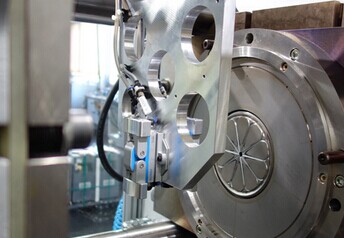New cutting technology for O-rings
Published on:16 Mar,2016
Lagrange/oberwihl. After years of intensive development work on Compression Molding (CM) technology, the competence center O-rings in LaGrange is making an investment in equipment for its Injection Molding (IM) processes. This is also making it possible for LaGrange to satisfy customers’ desires for O- or D-rings with large diameters and to close current gaps in its portfolio. In this project, employees at LaGrange worked very closely with their colleagues in Oberwihl and from NOK – “Innovating together.” The teams jointly developed new technologies in which standardized cutting and piercing processes and coating procedures are reaching a new stage of development.
“The project now stands for far more than ‘just’ a new O-ring process in LaGrange,” said Jonathan Staples, Competence Center Manager. “We have experienced a kind of cooperation between the Lead Center and the Competence Center that we have not had before.”
Numerous machines and processes from NOK are used in LaGrange. “But until now there have been very few IM presses or equipment from Germany, and we had not really cooperated closely with our colleagues there to that point,” he said.
Then as now, the order books in LaGrange were well-filled. But one day it became clear that the plant could gain considerable market share, especially for large diameter O-rings, that is, those with diameters between one hundred and three hundred millimeters. When a customer asked for this type of O-ring, which was to be color-coded for easier assembly, the “strategic” gap became even more important.
“We had not been competitive price-wise in large O-rings in some segments in North America over the last few years,” Staples said. “But we are now working with a new technology: First, the hose with a grooved structure is produced in the injection molding process. We then cut the hose segment into O-rings with the new cutting technology.” The color coding takes place in a downstream process. The Lead Center has also developed some new materials. Thanks to the two improvements, Freudenberg was again competing against its rivals with competitive prices. “Two years ago, employees in Oberwihl began to further develop their cutting technology. We introduced it in LaGrange as well when we received the first American order,” said Jason Facey, Process Technician in LaGrange. The rotational cutting technology certainly was not fundamentally new, but it was important for the team to further improve the process to minimize sprue and piercing waste, increase productivity, and produce an inherently more consistent product. Notwithstanding these advantages, the greatest challenge involved the production of the pierced rings with the precision that the customer wanted.
The plant needed new presses, turning machines and coating units to manufacture the necessary quantities in the required quality, Facey said.
The piercing process made additional special O-ring geometries possible, which expanded the product portfolios in both LaGrange and Oberwihl. To ensure that each rotationally cut O-ring had accurate dimensions, the plant had recently begun using a laser measuring device. At the customer’s special request, the product was supposed to be color-coded. Here NOK’s expertise was in demand.
The new equipment arrived in LaGrange in June 2015. During the following autumn, the development team from Oberwihl flew to the U.S. and spent three weeks helping their colleagues in LaGrange with the installation, checks and the initial sampling. Good news quickly followed. The customer approved the first samples, and nothing stood in the way of a series launch in mid-March 2016.